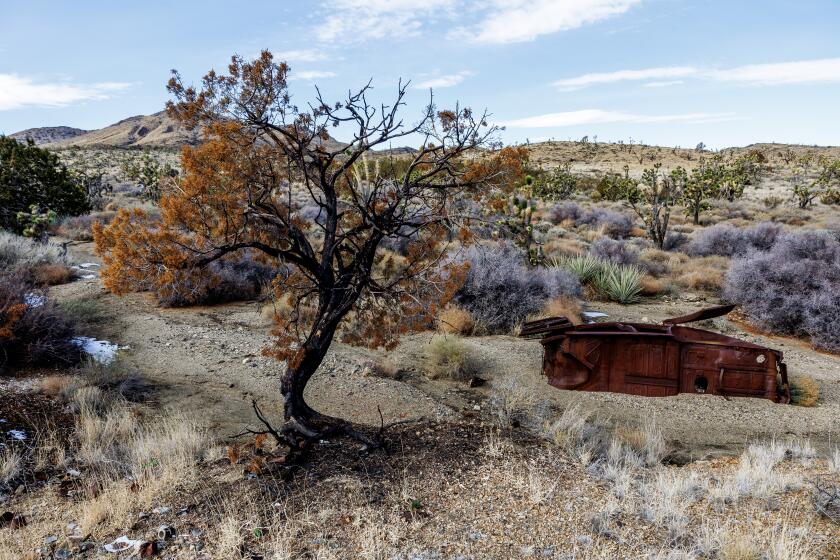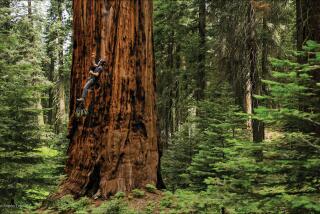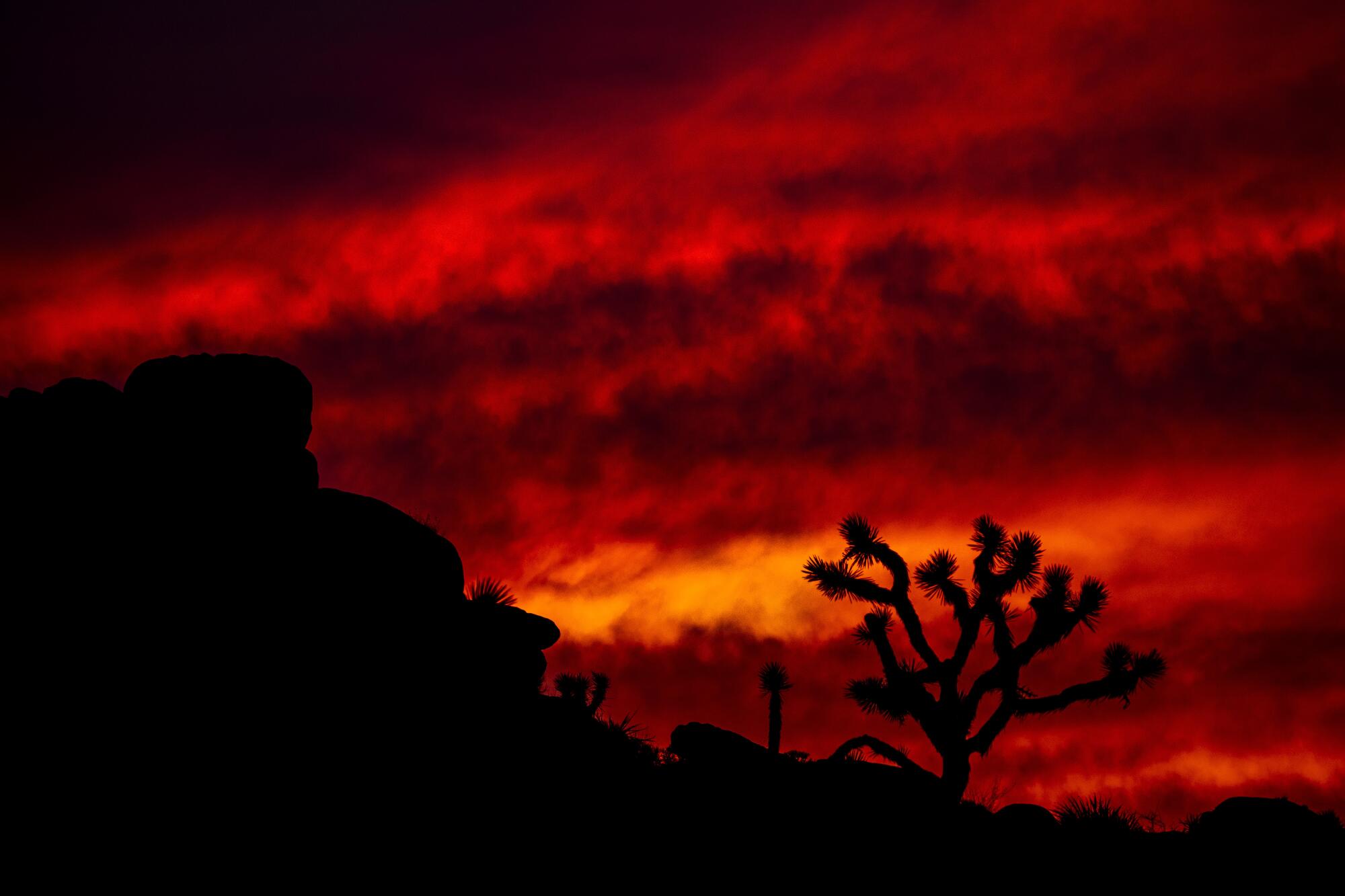
When a renewable energy company started razing thousands of Joshua trees this month to make way for a sprawling solar farm, it kicked up a firestorm of outrage among Mojave Desert residents and activists.
It was a public display of the prickly dilemma that conservationists face as they fight to preserve western Joshua trees. While the state is nearing completion of a draft conservation plan later this year, both climate change and solar projects are threatening the iconic trees’ desert habitat.
Climate scientists predict that by the end of the century, western Joshua trees will be able to survive on only 10% to 25% of the land they now inhabit. And as the Mojave and Colorado deserts continue to grow hotter and drier, the succulents will probably disappear almost entirely from Southern California — including from Joshua Tree National Park.
The problem, experts say, is that while many species can move northward and to higher elevations to escape increasing temperatures, Joshua trees are very slow to migrate and can’t keep up.
“Joshua trees are in this triple squeeze pinch,” said Christopher Smith, a professor of biology at Willamette University who co-wrote a 2023 paper exploring how to balance solar development and Joshua tree conservation.
A solar energy company will soon begin clearing thousands of protected Joshua trees in the Mojave Desert, including many thought to be a century old.
First, there’s climate change, Smith said. Next, there’s habitat loss due to urbanization and solar development. Finally, there’s increasingly intense wildfires — which can wipe out sizable percentages of all living Joshua trees in a single season.
“There are some places,” Smith said, “where half the trees have died, based on our censuses, over the past 15 years.”
After a years-long effort failed to get western Joshua trees — a distinct species from their eastern counterparts — listed as an endangered species in 2022, climate advocates and the state developed a law to conserve them. It ordered the California Department of Fish and Wildlife to draft a science- and Native-American-backed conservation plan by the end of 2024, and imposed fees for the removal of Joshua trees — fees that would be used to fund the conservation work.
For years, environmental groups and even government agencies have talked about moving the plants north as far as Oregon, to climates that will resemble Southern California’s in a hundred years’ time. However, Joshua tree scientists say that transplanting the species is not so simple.
Among other barriers to relocation, western Joshua trees rely on a single species of yucca moth to pollinate them. They also require a unique, underground network of fungi that shuttle nutrients to the trees. And scientists say there may be other species the plants rely on that they haven’t identified yet.
“I think most people would say it’s a Hail Mary pass,” Smith said of relocating the plants over a large distance. “To have those [trees] as a long-term legacy, and not just zoo animals, you need to also have a functioning ecosystem.”
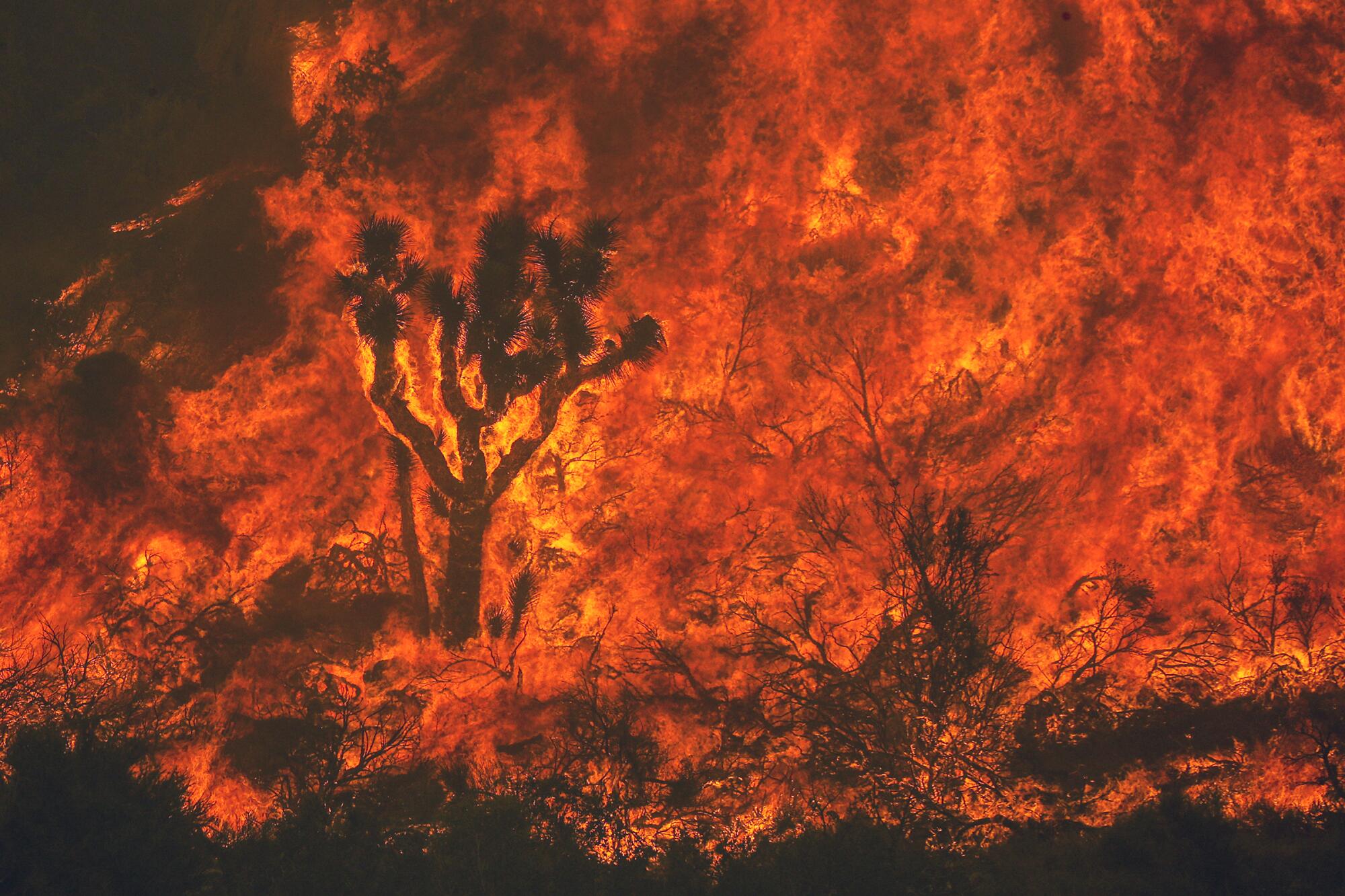
Instead, the Department of Fish and Wildlife is going on the defensive and focusing on protecting trees in select locations where they stand the best chance of survival. Scientists are using models of the future climate and maps of Joshua tree locations to pinpoint areas within the trees’ current habitat that will still have an acceptable climate in a hundred years.
Many of these areas, called climate refugia, are small — meaning scientists need extremely detailed maps to identify them. So, a team from the United States Geological Survey set out to make one. They studied almost 1 million points over more than 50,000 square miles on Google Earth; then, they drove more than 9,000 miles along paved and dirt roads over the course of 30 site visits to verify that the trees they saw in the satellite images were actually there.
The resulting data set, released in December 2023, is the battle map for the state’s army of conservationists and scientists. They are using it to identify refugia across the region — locations where they can deploy every defense in their arsenal and protect holdouts from land developers, wildfires, heat waves and drought.
Measures could include removing flammable brush, planting new Joshua trees and also working to conserve the entire ecosystem that the trees rely on, including the moths and fungi. The state has also asked scientists to look at how to make the trees more resilient.
Last year’s York fire has sparked discussion about how to deal with conflagrations in the Mojave National Preserve.
Researchers have sequenced the genomes of 300 Joshua trees and counting. From genetic maps like these, scientists have found that some populations of Joshua trees have genes that make them more resistant to hotter and drier conditions.
Although no research has been published on the topic yet, there is preliminary evidence that roots adapted to better collect nutrients with fungi may be more capable of sprouting a new tree after a forest fire, according to Smith. This budding body of research could help the state introduce specific adaptations into refugia — and generally work to keep genetic diversity high — essentially helping the Joshua trees adapt to climate change faster.
The state’s focus on refugia doesn’t mean all other Joshua trees are doomed, however. The conservation act includes a tree relocation program to move trees threatened by property development into these climate refuges. The Wildlands Conservancy, a nonprofit with dozens of preserves across the western U.S., also wants to provide homes for relocated Joshua trees.
For the record:
11:47 a.m. June 28, 2024A previous version of this article misidentified the Pioneertown Mountains Preserve as Pioneer Mountains Preserve and reported that it encompasses 2,500 acres. The preserve covers 25,500 acres.
In 2006, the Sawtooth complex fire decimated a Joshua tree woodland within the conservancy’s 25,500-acre Pioneertown Mountains Preserve, which is just northwest of Joshua Tree National Park. Tim Krantz, the group’s conservation director and emeritus professor of environmental studies at the University of Redlands, hopes to partner with the state to rebuild that forest with transplanted Joshua trees.
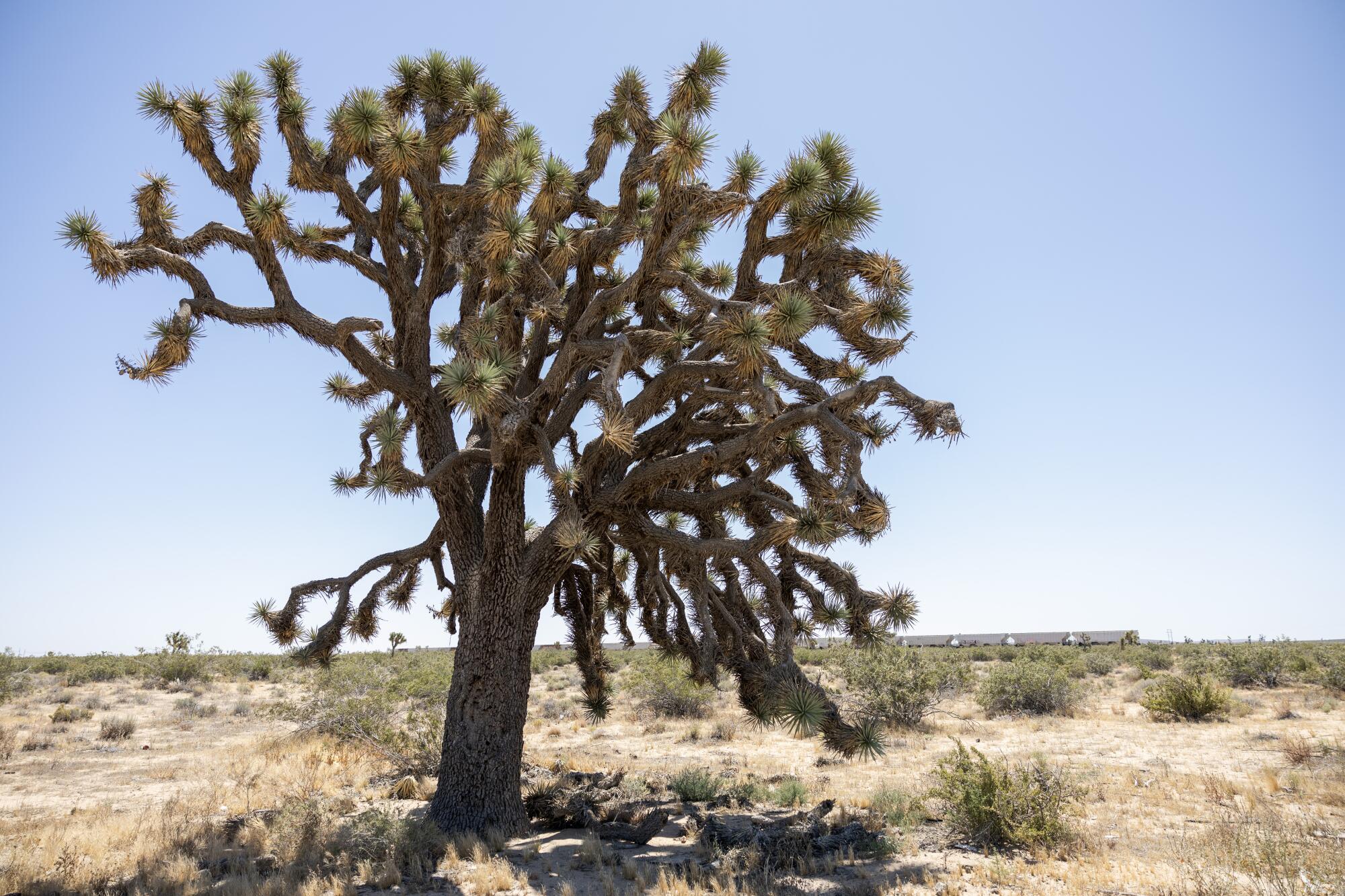
But moving an entire forest is not easy — or cheap. Conservationists need large hydraulic tree spades to scoop up the plants and their surrounding dirt. And when replanting the tree in another location, caretakers must ensure the same side of the succulent faces due north and follow an intensive watering regimen for the first few years after its move.
“We’re hoping to ultimately move hundreds of trees, and at that scale … there’s a lot of monitoring and maintenance that goes on — a lot of boots on the ground,” said Krantz, who used co-own a landscaping company that frequently moved trees, including Joshua trees.
While Krantz hopes the conservation fund could support the work, the fund — which finances all aspects of conservation — probably will not have enough money to pay for the entire pricey process of relocating every tree threatened by property development.
Scientists, state officials and tribes are still debating details of the conservation plan, but the Department of Fish and Wildlife isn’t waiting to act. One of the first steps in creating ecological fortresses around Joshua tree refugia is to ensure that the state either owns the land or has permission to perform conservation work there. In 2023, the department completed its first land acquisition with the nonprofit Native American Land Conservancy.
The site is not only a potential Joshua tree refuge but also a cultural site for the Kawaiisu tribe. Now, the land will be permanently conserved by tribes and the conservancy, which voluntarily entered a legally binding conservation easement, facilitated by the state.
“It does really reassure everybody that the land is being set aside for its intended purposes forever — because it gets recorded,” said Nicole Johnson, a lawyer who works with tribes and a board member of the Native American Land Conservancy.
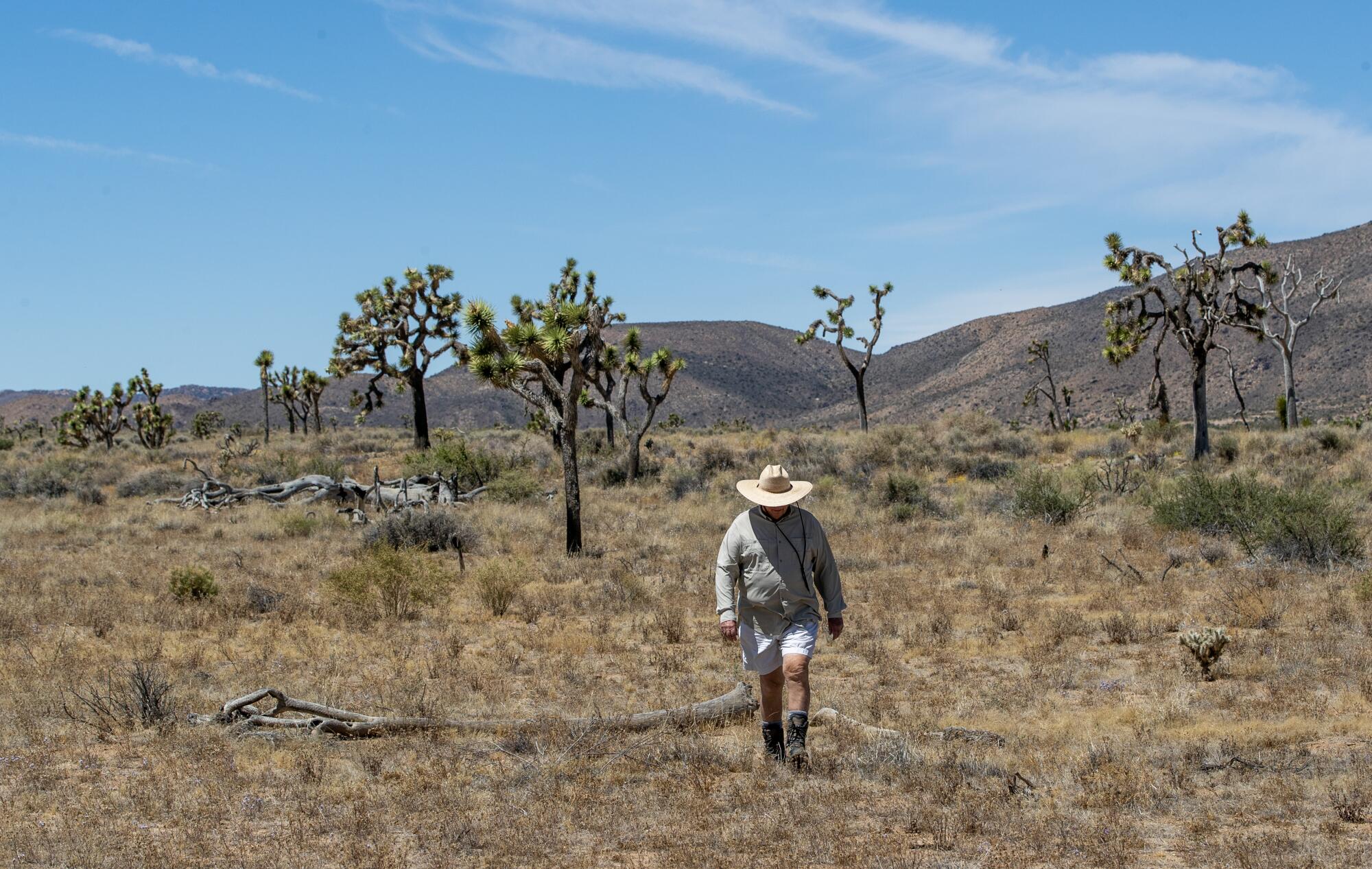
In addition to partnering with the Native American Land Conservancy, the state is working with more than a dozen native tribes to comanage the conservation plan and marry science with traditional ecological knowledge. However, building relationships with tribal governments takes time, said Drew Kaiser, a senior environmental scientist at the California Department of Fish and Wildlife who is coordinating the development of the conservation plan. The comanagement aspect of the plan is still in its early stages.
The department is also working with the solar project in the Mojave Desert near Boron to conserve more than 80,000 acres of Joshua tree habitat, according to the company. The state required the firm to pay more than $1.3 million into the conservation fund to offset the harm. However, the company isn’t planning to relocate any of the 4,700 trees.
For Smith, it’s a reality of the situation in which the state finds itself. “A lot of species are going to go extinct, and a lot of populations of Joshua trees … are going to die out. Where we’re at right now is, stop the bleeding and decide who to save.”
Toward a more sustainable California
Get Boiling Point, our newsletter exploring climate change, energy and the environment, and become part of the conversation — and the solution.
You may occasionally receive promotional content from the Los Angeles Times.

